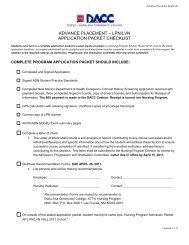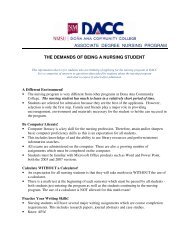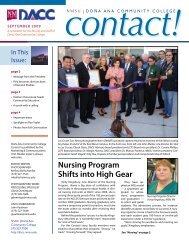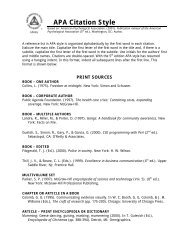Download - Dona Ana Community College
Download - Dona Ana Community College
Download - Dona Ana Community College
Create successful ePaper yourself
Turn your PDF publications into a flip-book with our unique Google optimized e-Paper software.
DACC Nursing Program Student Handbook 2012-2013All procedures or treatments performed must be within a nursing scope of practice. Administration ofblood and blood products is reserved for students at Level IV who have successfully passed the bloodadministration skills performance exam. Blood and blood products may only be administered under thedirect supervision of the preceptor.Students may only perform nursing skills or interventions for which they have receivedinstruction and demonstrated basic competency in the skills/simulation lab.4.8 TRANSPORTATION1. Students are to provide their own transportation to and from all clinical sites.2. Students may not transport patients/clients at any time.3. Clinical sites will vary and will not always be in Las Cruces.4. Clinical times vary and may include days, evenings, nights, holidays or weekends.4.9 UNSAFE CLINICAL PRACTICE DETERMINATIONUnsafe clinical behavior includes, but is not limited to, the following:1. Violates or threatens the physical safety of the patient. (i.e., medication errors, neglects use ofside rails, restraints; comes unprepared to clinical.)2. Violates or threatens the psychological safety of the patient. (i.e., uses non-therapeutictechniques repeatedly in interactions; attacks/derogates individual's beliefs or values.)3. Violates or threatens the microbiological safety of the patient. (i.e., unrecognized violation ofaseptic technique; failure to perform sterile preps or dressings appropriately.)4. Violates or threatens the chemical safety of the patient. (i.e., violates the "6 Rights inAdministering Medications"; fails to monitor IV infusions safely (count drops, know micromacrodrip ratio).5. Violates or threatens the thermal safety of the patient. (i.e., burns patient with hot packs, heatinglamp, etc.; fails to observe safety precautions during O2 therapy.)6. Violates or threatens the environmental safety of the patient. (i.e., fails to leave patient's room inorder; fails to remove harmful objects from room when appropriate (including personalmedications.)7. Inadequately and/or inaccurately utilizes the nursing process. (i.e., fails to observe and/or reportcritical data relating to patients/clients/families; makes repeated faulty judgments/decisions innursing situations.)8. Violates previously mastered principles/learning/objectives in carrying out nursing care skillsand/or delegated medical functions. (i.e., fails to seek guidance or instructions in theperformance of unfamiliar procedures.)9. Assumes inappropriate independence in action or decisions. (i.e., performs competencies nottested; fails to seek help in emergency situations.)10. Fails to recognize own limitations, incompetence, and/or legal responsibilities. (i.e., refuses toadmit errors noted by the instructor/nursing staff; cannot identify own legal responsibilities tospecific nursing situation; becomes defensive when corrected.)11. Fails to accept legal responsibility for his/her own actions. (i.e., covers own/other‘s errors or failsto report them; shares confidential information inappropriately)34 | P a g e







